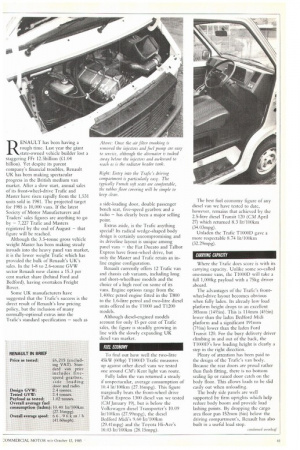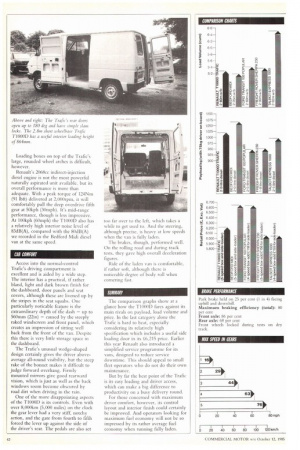R ENAULT has been having a rough time. Last year the
Page 43

Page 44

If you've noticed an error in this article please click here to report it so we can fix it.
giant state-owned vehicle builder lost a staggering FFr 12.5billion (£.1.04 billion). Yet despite its parent
company's financial troubles, Renault UK has been making spectacular progress in the British medium van market. After a slow start, annual sales of its front-wheel-drive Trafic and Master have risen rapidly from the 1,531 units sold in 1981. The projected target for 1985 is 10,000 vans. If the latest Society of Motor Manufacturers and Traders' sales figures are anything to go by — 7,227 Trafic and Masters registered by the end of August — that figure will be reached.
Although the 3.5-tonne gross vehicle weight Master has been making steady inroads into the heavy panel van market, it is the lower weight Trafic which has provided the bulk of Renault's UK's sales. In the 1-8 to 2.6-tonne GVW sector Renault now claims a 15.3 per cent market share (behind Ford and Bedford), having overtaken Freight Rover.
Some UK manufacturers have suggested that the Trafic's success is the direct result of Renault's low pricing policy, but the inclusion of many normally-optional extras into the Trafic's standard specification — such as
Above Once the air filter (narking removed the ;Terrors and .fuel pump are easy to service, although the alternator is tucked away below the ;Terrors and awkward to reach as is the radiator header tank.
Right: Entry into the Trafic's driving compartment is particularly easy. The typically French soft sears are comfortable, the rubber floor covering will be simple to keep clean.
a side-loading door, double passenger bench scat, five-speed gearbox and a radio — has clearly been a major selling point.
Extras aside, is the Trafic anything special? Its radical wedge-shaped body design is certainly uncompromising and its driveline layout is unique among panel vans — the Fiat Ducato and Talbot Express have front-wheel drive, but only the Master and Trafic retain an inline engine configuration.
Renault currently offers 12 Trafic van and chassis cab variants, including long and short-wheelbase models and the choice of a high roof on sonic of its vans. Engine options range from the 1,400ce petrol engine fitted in the T800 to the 1.6-litre petrol and two-litre diesel units offered in the T1000 and T1200 models.
Although diesel-engined models account for only 15 per cent of Trafic sales, the figure is steadily growing in line with the slowly expanding UK diesel van market.
FUEL ECONOMY To find out how well the two-litre 45kW (60hp) T1000D Trafic measures up against other diesel vans we tested one around CM's Kent light van route.
Fully laden the van returned a steady if unspectacular, average consumption of 10.4 lit/100km (27.16mpg). This figure marginally beats the front-wheel drive Talbot Express 1300 diesel van we tested (CM January 19), hut is below the Volkswagen diesel Transporter's 10.09 lit/1(X)km (27.99mpg), the diesel Bedford Midi's 9.60 lit/100km (29.41mpg) and the Toyota Hi-Ace's 10.03 lit/100km (28.15mpg). The best fuel economy figure of any diesel van we have tested to date, however, remains that achieved by the 2.5-litre diesel Transit 120 (CM April 27) which returned 8.3 lit/100km (34.03mpg).
Unladen the Trafic T1000D gave a more respectable 8.74 lir/100km (32.29mpg).
CARRY/NC CAPACITY Where the Trafic does score is with its carrying capacity. Unlike some so-called one-tonne vans, the T10001) will take a full 1,000kg payload with a 75kg driver aboard.
The advantages of the Trafic's frontwheel-drive layout becomes obvious when fully laden. Its already low load platform height drops to an excellent 385rnm (14%2in). This is 114mm (41/2in) lower than the laden Bedford Midi platform and a significant 191mm (71/2in) lower than the laden Ford Transit 120. For the busy delivery driver climbing in and out of the back, the T1000I)'s low loading height is clearly a step in the right direction.
Plenty of attention has been paid to the design of the Trafic's van body. Because the rear doors are proud rather than flush fitting, there is no bottom sealing lip or raised door catch on the body floor. This allows loads to he slid easily out when unloading.
The body side panels are well supported by firm uprights which help reduce body boom and provide load lashing points. By dropping the cargo area floor pan 152mm (fin) below the driving compartment's, Renault has also built in a useful load stop.
Loading boxes on top of the Trafic's large, rounded wheel arches is difficult, however. Renault's 2068cc indirect-injection diesel engine is not the most powerful naturally aspirated unit available, but its overall performance is more than adequate. With a peak torque of 124Nlin (91 lbft) delivered at 2,00Orpm, it will comfortably pull the deep overdrive fifth gear at 50kph (30rnph). It's mid-range performance, though is less impressive. At 100kph (60mph) the T1000D also has a relatively high interior noise level of 83dB(A), compared with the 80dB(A) we recorded in the Bedford Midi diesel van at the same speed.
CH COMFORT
Access into the normal-control Trafic's driving compartment is excellent and is aided by a wide step. The interior has a practical, if rather bland, light and dark brown finish for the dashboard, door panels and seat covers, although these are livened up by the stripes in the seat squabs. One particularly noticable feature is the extraordinary depth of the dash — up to 560mm (22in) — caused by the steeply raked windscreen and front panel, which creates an impression of sitting well back from the front of the van. Despite this there is very little storage space in the dashboard. The Trafic's unusual wedge-shaped design certainly gives the driver aboveaverage all-round visibility, but the steep rake of the bonnet makes it difficult to judge forward overhang. Firmly mounted mirrors give good rearward vision, which is just as well as the back windows soom become obscured by road dirt when driving in the rain. One of the more disappointing aspects of the T1000D is its controls. Even with over 8,00{)km (5,000 miles) on the clock the gear lever had a very stiff, notchy action, and the gate from fourth to fifth forced the lever up against the side of the driver's scat. The pedals are also set too far over to the left, which takes a while to get used to. And the steering, although precise, is heavy at low speeds when the van is fully laden. The brakes, though, performed well. On the rolling road and during track tests, they gave high overall deceleration figures. Ride of the laden van is comfortable, if rather soft, although there is noticeable degree of body roll when Cornering fast.
SIIMMARY
The comparison graphs show at a glance how the T1000D fares against its main rivals on payload, load volume and price. In the last category alone the Trafic is hard to beat, especially considering its relatively high specification which includes a useful side loading door in its. 0,215 price. Earlier this year Renault also introduced a simplified service programme for its vans, designed to reduce service downtime. This should appeal to small fleet operators who do not do their own maintenance. But by far the best point of the Trafic is its easy loading and driver access, which can make a big difference to productivity on a busy delivery round. For those concerned with maximum driver comfort, however, its control layout and interior finish could certainly be improved. And operators looking for maximum fuel economy will not be so impressed by its rather average fuel economy when running fully laden.












































































































